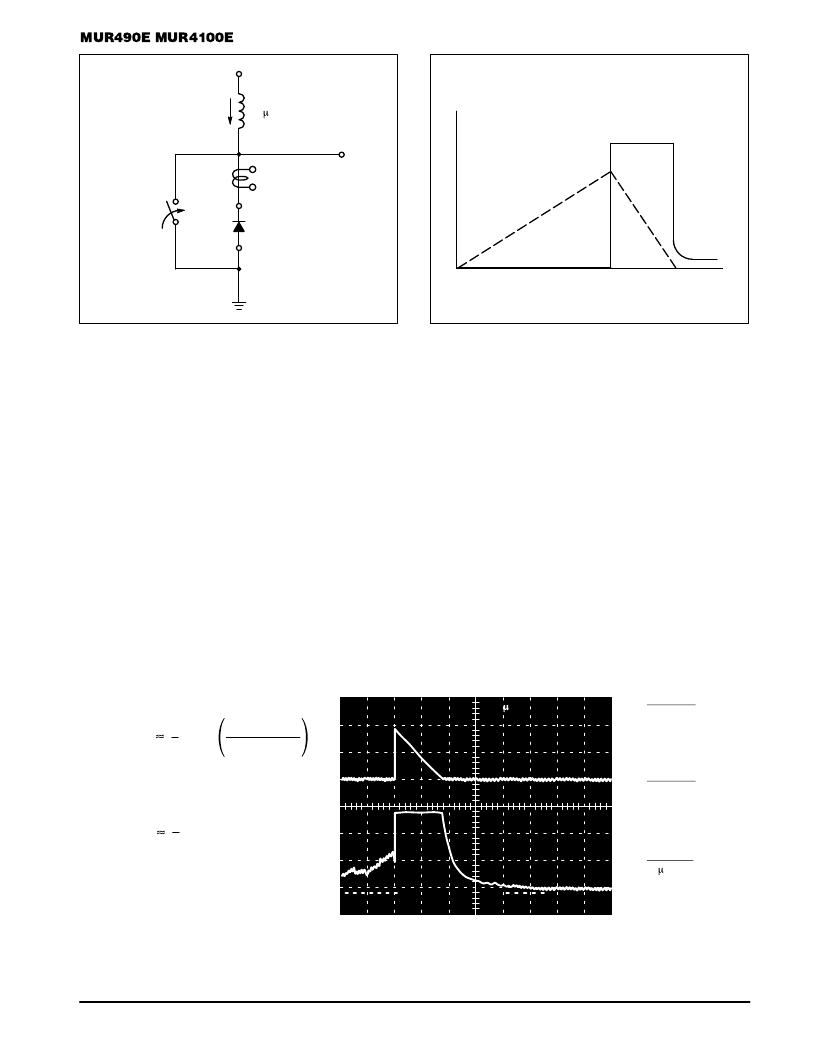- 您現(xiàn)在的位置:買賣IC網(wǎng) > PDF目錄371155 > MUR490E (MOTOROLA INC) ULTRAFAST RECTIFIERS 4.0 AMPERES 900-1000 VOLTS PDF資料下載
參數(shù)資料
| 型號: | MUR490E |
| 廠商: | MOTOROLA INC |
| 元件分類: | 參考電壓二極管 |
| 英文描述: | ULTRAFAST RECTIFIERS 4.0 AMPERES 900-1000 VOLTS |
| 中文描述: | 4 A, 900 V, SILICON, RECTIFIER DIODE |
| 文件頁數(shù): | 4/6頁 |
| 文件大小: | 120K |
| 代理商: | MUR490E |

4
Rectifier Device Data
t0
t1
t2
t
VDD
ID
IL
BVDUT
MERCURY
SWITCH
Figure 6. Test Circuit
Figure 7. Current–Voltage Waveforms
+VDD
DUT
40 H COIL
VD
IL
S1
ID
The unclamped inductive switching circuit shown in
Figure 6 was used to demonstrate the controlled avalanche
capability of the new “E’’ series Ultrafast rectifiers. A mercury
switch was used instead of an electronic switch to simulate a
noisy environment when the switch was being opened.
When S1 is closed at t0 the current in the inductor IL ramps
up linearly; and energy is stored in the coil. At t1 the switch is
opened and the voltage across the diode under test begins to
rise rapidly, due to di/dt effects, when this induced voltage
reaches the breakdown voltage of the diode, it is clamped at
BVDUT and the diode begins to conduct the full load current
which now starts to decay linearly through the diode, and
goes to zero at t2.
By solving the loop equation at the point in time when S1 is
opened; and calculating the energy that is transferred to the
diode it can be shown that the total energy transferred is
equal to the energy stored in the inductor plus a finite amount
of energy from the VDD power supply while the diode is in
breakdown (from t1 to t2) minus any losses due to finite com-
ponent resistances. Assuming the component resistive ele-
ments are small Equation (1) approximates the total energy
transferred to the diode. It can be seen from this equation
that if the VDD voltage is low compared to the breakdown
voltage of the device, the amount of energy contributed by
the supply during breakdown is small and the total energy
can be assumed to be nearly equal to the energy stored in
the coil during the time when S1 was closed, Equation (2).
The oscilloscope picture in Figure 8, shows the information
obtained for the MUR8100E (similar die construction as the
MUR4100E Series) in this test circuit conducting a peak cur-
rent of one ampere at a breakdown voltage of 1300 volts,
and using Equation (2) the energy absorbed by the
MUR8100E is approximately 20 mjoules.
Although it is not recommended to design for this condi-
tion, the new “E’’ series provides added protection against
those unforeseen transient viruses that can produce unex-
plained random failures in unfriendly environments.
WAVAL
1
2LI2
LPK
BVDUT
BVDUT–VDD
WAVAL
1
2LI2
LPK
Figure 8. Current–Voltage Waveforms
CHANNEL 2:
IL
0.5 AMPS/DIV.
CHANNEL 1:
VDUT
500 VOLTS/DIV.
TIME BASE:
20 s/DIV.
EQUATION (1):
EQUATION (2):
CH1
CH2
REF
REF
CH1
CH2
ACQUISITIONS
SAVEREF SOURCE
1
217:33 HRS
STACK
A
20 s
953 V
VERT
500V
50mV
相關PDF資料 |
PDF描述 |
|---|---|
| MUR4100E | ULTRAFAST RECTIFIERS 4.0 AMPERES 900-1000 VOLTS |
| MUR5150E | SCANSWITCH RECTIFIER 5.0 AMPERES 1500 VOLTS |
| MUR6040 | ULTRAFAST RECTIFIERS 60 AMPERES 400 VOLTS |
| MURH8100E | ULTRAFAST RECTIFIER 8.0 AMPERES 1000 VOLTS |
| MURH840CT | ULTRAFAST RECTIFIER 8.0 AMPERES 400 VOLTS |
相關代理商/技術參數(shù) |
參數(shù)描述 |
|---|---|
| MUR490E/D | 制造商:MOTOROLA 制造商全稱:Motorola, Inc 功能描述:SWITCHMODE Ultrafast Power Rectifier |
| MUR490E_06 | 制造商:ONSEMI 制造商全稱:ON Semiconductor 功能描述:ULTRAFAST RECTIFIERS 4.0 AMPS, 900 - 1000 VOLTS |
| MUR4G0 | 制造商:ON Semiconductor 功能描述: |
| MUR5005 | 功能描述:整流器 50V 50A Super Fast Recovery RoHS:否 制造商:Vishay Semiconductors 產(chǎn)品:Standard Recovery Rectifiers 配置: 反向電壓:100 V 正向電壓下降: 恢復時間:1.2 us 正向連續(xù)電流:2 A 最大浪涌電流:35 A 反向電流 IR:5 uA 安裝風格:SMD/SMT 封裝 / 箱體:DO-221AC 封裝:Reel |
| MUR5005R | 功能描述:整流器 50V 50A REV Leads Super Fast Recovery RoHS:否 制造商:Vishay Semiconductors 產(chǎn)品:Standard Recovery Rectifiers 配置: 反向電壓:100 V 正向電壓下降: 恢復時間:1.2 us 正向連續(xù)電流:2 A 最大浪涌電流:35 A 反向電流 IR:5 uA 安裝風格:SMD/SMT 封裝 / 箱體:DO-221AC 封裝:Reel |
發(fā)布緊急采購,3分鐘左右您將得到回復。